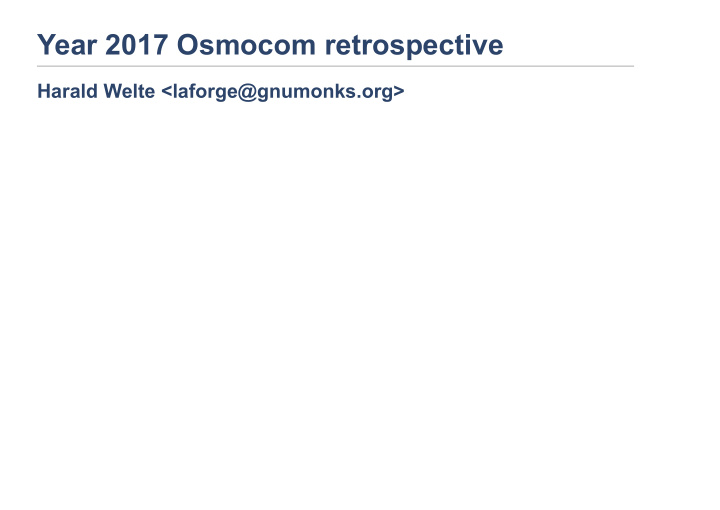



Year 2017 Osmocom retrospective Harald Welte <laforge@gnumonks.org>
2017 - a year of change Osmocom CNI (Cellular Network Infrastructure) has changed a lot: software changes team / developer changes sysmocom company focus changes
2017 - CNI Software changes OsmoBSC migration from SCCPlite to 3GPP AoIP OsmoMGW as integral part of both BSC and MSC NITB split into separate MSC, HLR, BSC 3G (IuCS, IuPS) goes mainline
2016/2017/2018 - Team changes Q1 2016: Jacob Erlbeck leaves sysmocom unfortunately a complete loss to Osmocom, particularly OsmoPCU 2017: Holger Freyther leaves sysmocom unfortunately also shift of focus away from Osmocom :( immense loss to the project in terms of skill and capacity Q1 2018: Max Suraev leaves sysmocom another loss of lots of Osmocom knowledge
sysmocom changes we used to have to do lots of non-Osmocom work to cross-subsidize Osmocom big distraction of resources in 2014/2015, now gone we used to cross-subsidize Osmocom development by hardware sales not happening as much anymore we now work almost 100% on Osmocom R&D projects, support contracts and grants
split NITB aftermath (the good parts) biggest architectural change since we started in 2008 lots of good reasons and design improvements finite state machines with proper timeouts / clean-up proper 3GPP AoIP with interoperability tesing no synchronous HLR database access HLR access from OsmoMSC and OsmoSGSN 2G/3G authentication over GERAN and UTRAN
split NITB aftermath (the bad parts) never-ending list of breakage actual regressions of things that used to work before things that were known omissions during the restructuring some commercial users stuck with SCCPlite and thus old @osmo-bsc- sccplite@ almost none of the new features or bug fixes there no automatic testing back-ports time-consuming
split NITB aftermath (lessons learned) overall complexity of Osomcoom cellular is quite stunning now absence of proper functional testing has caused massive fall-out the split architecture allows for betteer testing of smaller parts of the system my personal main focus of the last 5+ months: testing, testing, testing, testing testing, testing, testing, testing some more testing even more testing
Osmocom CNI testing (1/2) unit test (autotest, like we always had) test individual functions / APIs of libraries / programs executed during "make check" and hence before any patch can get merged automatized functional tests in TTCN-3 test external visible behavior on interfaces such as Abis, A, GSUP, GTP, MNCC, PCUIF, CTRL, VTY, … executed nightly by Jenkins (could be more frequently)
Osmocom CNI testing (2/2) osmo-gsm-tester tests entire Osmoocom network with BTS/BSC/MSC/HLR/PCU/SGSN/GGSN/… uses real BTS + MS hardware (over coaxial cable) automatic execution multiple times per day interop tests against NG40 RAN + CN simulator from NG4% (A / Gb / Iu level) not fully automatized yet
Osmocom project health (CNI) lots of funded developments, but primarily enterprise features required by professional users dominance of sysmocom is problematic sustainable FOSS has no single point of failure! we need more contributions from third parties particularly those that benefit commercially from Osmocom
Osmocom project health (other projects) OsmocomTETRA dead since 2012, occasional small fixes No OsmocomBB ports to other PHY/chip yet OsmocomDECT completely dead Erlang core network projects dead Smalltalk projects dead (AFAICT) SIMtrace dead for years, about to be resurrected
Osmocom project health (other projects) gr-osmosdr very low commit ratio rtl-sdr no commits in 2015-2017 but it’s not that bad… (see next slide)
Osmocom project health (other projects) gr-gsm, fake_trx and trxcon a welcome change in OsmocomBB osmocom-analog (jolly to the rescue) osmo-fl2k (soon! now! this year!)
Osmocom status (CNI) CS RAN (BTS, BSC) is quite strong/complete these days ready to be used with 3rd party CN PS RAN (PCU) suffers from lack of attention lack of automatic testsuite with decent coverage lack of uplink multi-slot any many EGPRS features CS CN (MSC, HLR) in halthy state, but lack of TCAP/MAP interface limits us to non- roaming networks PS CN (SGSN, GGSN) in good health, now with IPv6 supoprt and kernel GTP acceleration
Osmocom outlook (CNI) 2G still in demand by lots of use cases (rural, maritime, …) if we had TCAP/MAP interface, many more deployments possible 3G has some users but lack of FOSS RNC limits us to femtocells 4G is deployed in parallel to 2G in many scenarios Osmocom 2G stack needs 2G-4G integration (SGs, DIAMETER) Osmocom needs to contribute to FOSS 4G projects (nextepc, srsLTE) irony: Now that it’s possible to do properly funded Osmocom development, we have less people involved than in the early days :( If we don’t manage to focus on 4G soon, interest in 2G will diminish soon
Osmocom outlook (other projects) activity of original/traditional Osmocom developers decreased without attracting more developers, a lot of projects will remain dormant and/or never realize their potential I’d love to work on TETRA, DMR or other mobile communications technology but lack of developers and contributors even for 2G makes me stuck in 2G CNI land :(
Personal Request Osmocom needs you! we’ve lost too many friends already please don’t leave Osmocom; please don’t leave me
Further Reading See my detailed 2017 review: * http://osmocom.org/news/84
EOF End of File
Recommend
More recommend